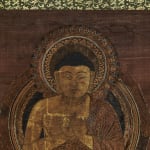Embroidered Amitabha Buddha
Color and embroidery on silk, hanging scroll
Early 17th century
With authentication by Oga Ichiro
Double boxed
52.3 x 30 cm
133 x 44 cm (overall)
Further images
A seated Amitabha is represented in sophisticated embroidery. Notably, the technique of komadome-nui, or couching stitch, with gold metallic thread, is applied lavishly over the work, from the Buddha’s drapery, lotus pedestal to nimbus. Different embroidery techniques, such as the hira-nui (satin stitch) of the garment, the sagara-nui (knotted stitch) of the hair coils, and the sashi-nui (technique making use of long and short stitches) that creates the ungen-nui (gradation), are meticulously executed, embodying the maker’s dedicated faith. In comparison to the all over embroidered Buddha images of the early medieval period, the present work which leaves the Buddha’s face and body painted but unembroidered might date later. Harmonious application of embroidery on the garment and other embellishments, as well as the impressed gold foil employed on the Buddha’s body, suggest that this work was made with a certain decorative intention. The mudra of this Buddha is not found in the most recognized “Mudra of the Nine Levels of Rebirth” of Amitabha. However, it is similar to that of Amitabha as the principle Buddha of the Taima Mandara dated earlier. Thus, as an individual deity, this Buddha might be derived from the principal Buddha of the Taima Mandala. The present work might be made in the beginning of early modern Japan, dating from Momoyama period to early Edo period.
Oga Ichiro, the scholar who studied the Woven Taima Mandara, a National Treasure, wrote the authentication of the present work. He noted that it is attributed to Princess Chujo, the legendary young noblewoman of the Nara period. This attribution is found in nearly all survived embroidered images of Buddha dating after the medieval period. This is perhaps because of the populization of the Pure Land Buddhism and the spread of the legends of the Woven Taima Mandara and Princess Chujo.
Oga Ichiro, the scholar who studied the Woven Taima Mandara, a National Treasure, wrote the authentication of the present work. He noted that it is attributed to Princess Chujo, the legendary young noblewoman of the Nara period. This attribution is found in nearly all survived embroidered images of Buddha dating after the medieval period. This is perhaps because of the populization of the Pure Land Buddhism and the spread of the legends of the Woven Taima Mandara and Princess Chujo.







